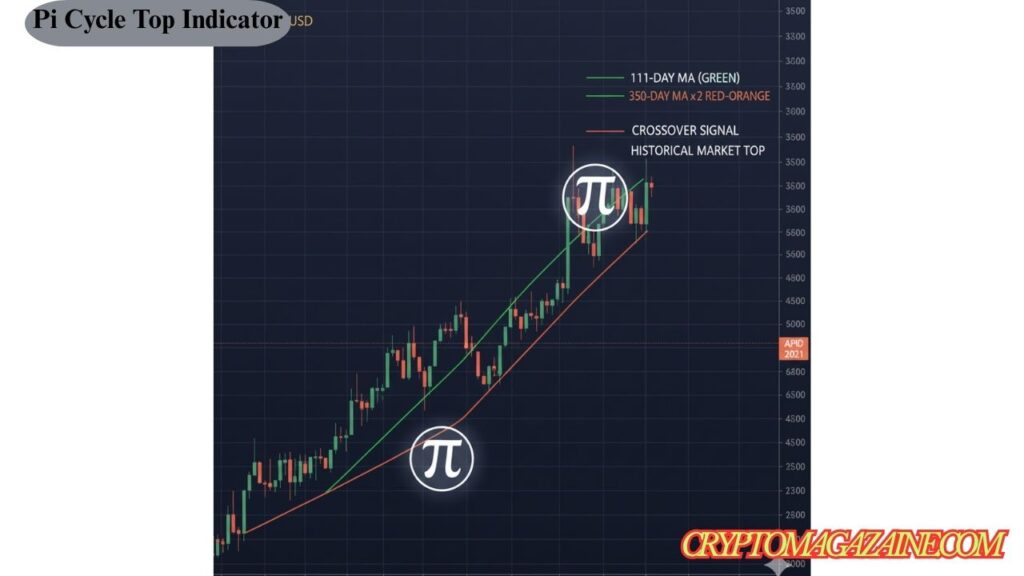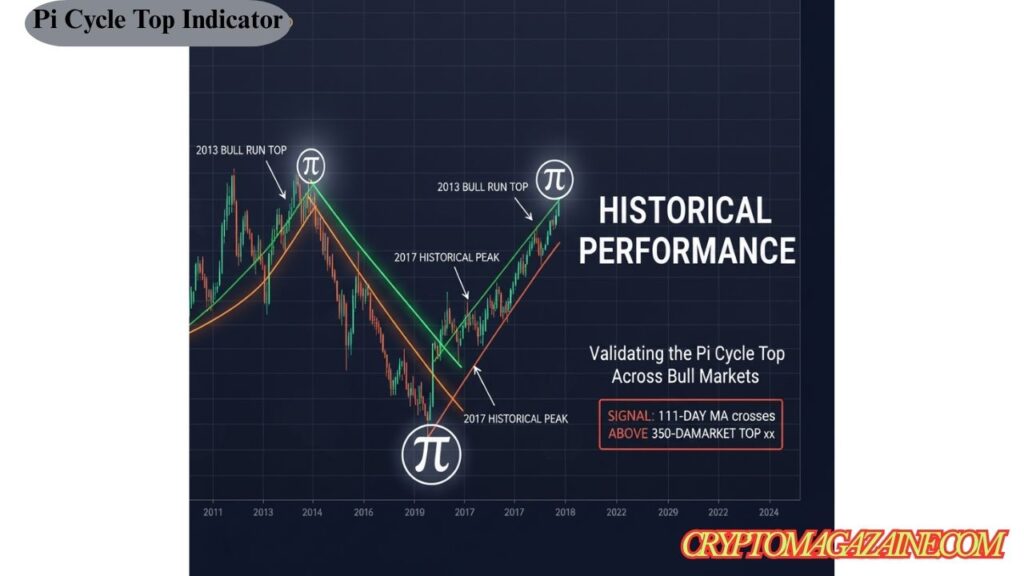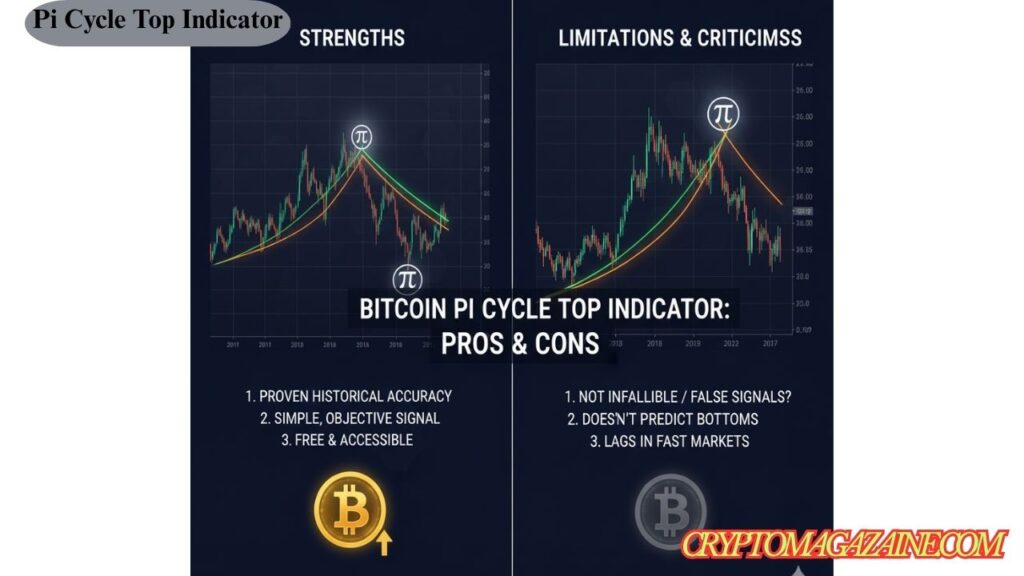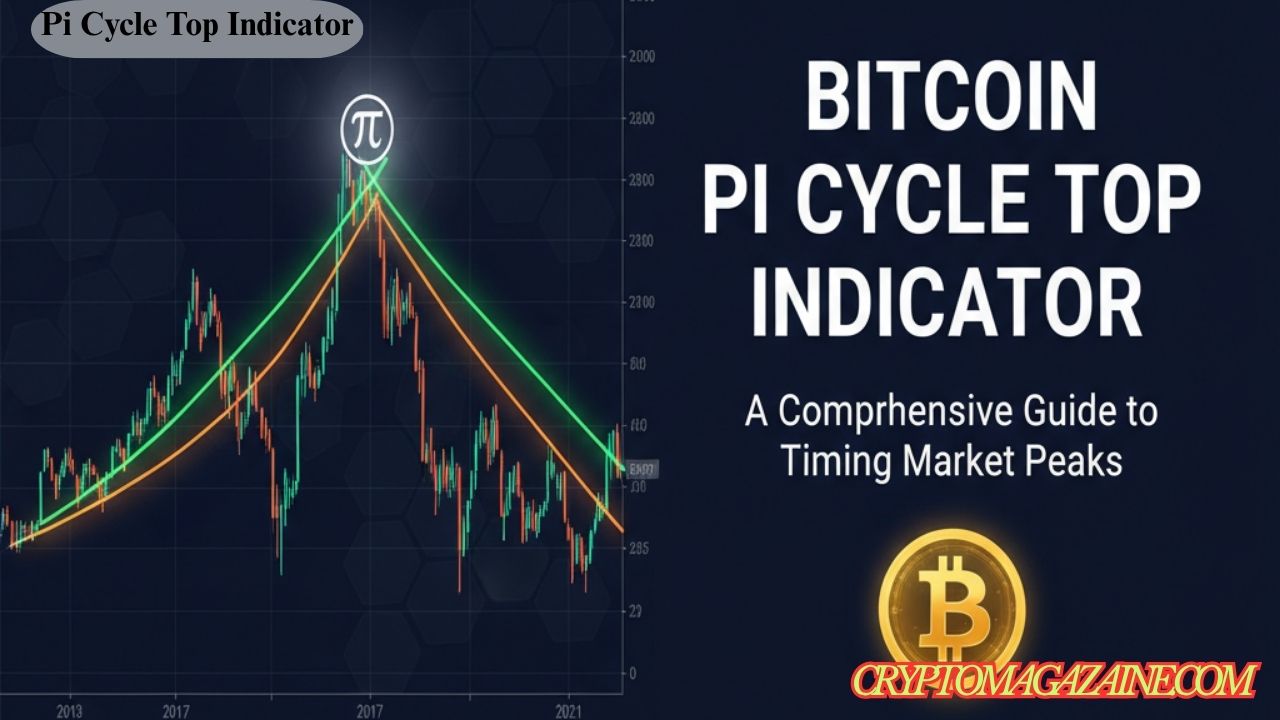Introduction
Bitcoin has captivated investors worldwide with its dramatic price cycles, characterized by explosive rallies followed by significant corrections. Understanding these market cycles has become essential for traders seeking to optimize their entry and exit points. While timing the market perfectly remains challenging, various technical indicators have emerged to help investors navigate Bitcoin’s volatile landscape.
Timing indicators play a crucial role in helping traders make informed decisions about when to take profits or increase exposure. These tools analyze historical price patterns and mathematical relationships to identify potential turning points in the market. Among the numerous indicators available to cryptocurrency traders, one has gained particular attention for its remarkable historical accuracy.
The bitcoin pi cycle top indicator stands out as one of the most reliable tools for identifying market tops in Bitcoin’s price history. This unique technical indicator has successfully predicted major peaks across multiple bull markets, earning respect from both retail traders and professional analysts. Unlike subjective analysis methods, it provides clear, objective signals based on mathematical relationships between moving averages.
Understanding the Pi Cycle Top Indicator

Basic Definition
The pi cycle top indicator bitcoin traders rely on is a technical analysis tool specifically designed to identify potential market tops during Bitcoin bull runs. Created by analyst Philip Swift, this indicator has garnered significant attention due to its impressive track record of calling major price peaks with remarkable precision.
At its core, the indicator operates on a straightforward principle: it monitors the relationship between two specific moving averages of Bitcoin’s price. When these moving averages cross in a particular way, they generate a signal suggesting that Bitcoin may be approaching or reaching a cyclical top. This mathematical approach removes emotional bias from decision-making, providing traders with an objective reference point during periods of market euphoria.
The beauty of this tool lies in its simplicity and accessibility. Unlike complex proprietary systems that require expensive subscriptions or specialized knowledge, the pi cycle top indicator can be accessed freely by anyone with basic charting capabilities. Its clear visual representation makes it easy for both novice and experienced traders to understand and implement in their trading strategies.
The Mathematics Behind It
The indicator’s mechanics involve two key components that work together to generate signals. The first component is the 111-day moving average, which tracks the average closing price of Bitcoin over the previous 111 days. This shorter-term moving average responds more quickly to price changes, providing a dynamic representation of recent market momentum.
The second component involves the 350-day moving average multiplied by 2. This creates a longer-term reference line that moves more slowly and represents broader market trends. By doubling this longer moving average, the indicator creates a specific threshold that the shorter average must cross to generate a signal.
The choice of these specific numbers carries mathematical significance, though the exact reasoning behind the “Pi” naming remains somewhat enigmatic. Some analysts suggest the ratio between these numbers approximates certain mathematical relationships, while others believe the name simply reflects the indicator’s cyclical nature. Regardless of the naming origin, the practical application has proven remarkably effective.
The crossover signal occurs when the 111-day moving average rises above the 350-day moving average multiplied by 2. This specific configuration has historically coincided with Bitcoin reaching local or absolute price peaks, making it a powerful alert system for traders looking to protect profits or reduce exposure near market tops.
How the Indicator Works

Signal Mechanics
The bitcoin pi cycle signal activates through a specific mechanical process that traders can easily identify on price charts. During a typical bull market, Bitcoin’s price rises steadily, causing both moving averages to trend upward. However, these averages move at different speeds due to their different timeframes.
As Bitcoin enters the later stages of a bull run, price acceleration often intensifies. This rapid price increase causes the shorter 111-day moving average to rise faster than the longer-term reference line. When momentum reaches extreme levels, the shorter average eventually crosses above the 350-day moving average multiplied by 2, generating the top signal.
Visual representation on price charts typically shows the 111-day moving average as one line and the doubled 350-day moving average as another. Traders watch for the moment when these lines intersect, with the shorter average crossing from below to above. This crossover moment has historically marked periods when taking profits or reducing positions proved advantageous.
During bull markets, the indicator typically remains dormant for extended periods, with the two moving averages maintaining separation. As the market heats up and price momentum intensifies, the gap between these averages narrows. The final crossing represents the culmination of sustained upward pressure, often coinciding with peak market euphoria and excessive valuations.
Historical Performance
The indicator’s credibility stems largely from its impressive historical track record across multiple Bitcoin market cycles. In the 2013 bull market top, the signal accurately identified the price peak that preceded a significant correction. This early success established the indicator’s reputation, though it would need to prove itself across additional cycles to gain widespread acceptance.
The 2017 bull market peak provided another validation point for the pi cycle. As Bitcoin surged toward $20,000, the indicator generated its signal within days of the actual top, giving traders a clear warning that the market had reached unsustainable levels. The subsequent correction of over 80% demonstrated the value of heeding such technical warnings.
The 2021 market cycle presented a more complex scenario, as Bitcoin experienced multiple significant rallies throughout the year. The indicator generated signals during periods of local exhaustion, though the evolving market structure raised questions about whether traditional cycle patterns would continue to hold. This cycle highlighted both the indicator’s utility and its limitations in rapidly changing market conditions.
Across these historical examples, the accuracy rate has been remarkably high, though not perfect. The indicator typically signals within days or weeks of actual tops, providing traders with actionable timing information. However, precision timing to the exact day remains elusive, emphasizing the importance of using the indicator as part of a broader risk management strategy rather than a perfect market timing tool.
Strengths of the Pi Cycle Top Indicator

Historical accuracy in calling major tops represents the indicator’s most compelling strength. Across multiple market cycles spanning over a decade, the bitcoin pi cycle top indicator has consistently provided warnings near significant price peaks. This track record has earned it credibility among both technical analysts and fundamental investors seeking objective reference points for portfolio management.
The simple, objective nature of the signal removes subjective interpretation from the equation. Unlike pattern-based analysis that requires traders to identify formations like head and shoulders or triangles, this indicator generates clear mathematical signals. When the crossover occurs, there’s no ambiguity about whether the signal has triggered, eliminating the psychological biases that often plague trading decisions.
Free accessibility stands as another significant advantage in an industry often dominated by expensive subscription services and proprietary tools. Anyone can access the pi cycle top indicator through free charting platforms, democratizing sophisticated technical analysis. This accessibility has helped the indicator gain widespread adoption across the trading community, from retail investors to professional fund managers.
The indicator’s performance across different market conditions demonstrates its robustness. Whether Bitcoin rallies due to retail FOMO, institutional adoption, or macroeconomic factors, the mathematical relationships underlying the indicator continue to provide relevant signals. This consistency across varying fundamental backdrops suggests the indicator captures something fundamental about market psychology and price momentum.
Limitations and Criticisms
Despite its impressive track record, the indicator is not infallible and has generated discussion about potential false signals. As with any technical tool, past performance doesn’t guarantee future results. Market structure evolves, and the factors driving Bitcoin’s price cycles may change over time, potentially affecting the indicator’s reliability.
The indicator doesn’t predict bottoms or entry points, focusing exclusively on identifying potential tops. This limitation means traders need additional tools or strategies to determine when to re-enter the market after selling near a top signal. The indicator provides valuable exit guidance but offers no insight into optimal accumulation periods.
Lag in fast-moving markets presents another consideration. Because the indicator relies on moving averages, which are inherently backward-looking calculations, there’s always some delay between actual price action and signal generation. In particularly volatile markets, this lag could mean missing the absolute peak by days or weeks, though historically this hasn’t significantly diminished the indicator’s utility.
The indicator’s foundation in past performance raises philosophical questions about its future effectiveness. As more traders become aware of and act upon the signal, the indicator itself could theoretically influence market behavior, potentially altering the patterns it was designed to identify. This self-referential dynamic represents a challenge for all widely-followed technical indicators.
Fundamental changes in Bitcoin adoption, such as institutional investment or integration into traditional financial systems, may alter cycle dynamics. The indicator doesn’t account for structural shifts in market composition, liquidity, or use cases. As Bitcoin matures as an asset class, historical patterns may evolve, requiring traders to reassess the indicator’s relevance.
How to Use the Indicator in Trading
Risk Management Applications
Taking partial profits near signal activation represents a prudent approach to using the indicator. Rather than attempting to sell entire positions at the exact top, many traders use the signal as a trigger to reduce exposure gradually. This strategy allows them to lock in gains while maintaining some upside participation if the market continues higher.
Adjusting position sizes based on the indicator’s status helps manage risk throughout market cycles. When the indicator shows the moving averages approaching each other, traders might consider reducing new purchases or avoiding leverage. Conversely, when the indicator remains far from signaling, more aggressive position sizing may be appropriate for risk-tolerant investors.
Setting stop losses or profit-taking targets in relation to the indicator provides a systematic approach to exit strategy. Some traders establish rules to sell specific percentages of their holdings when the signal triggers, removing emotional decision-making from the process. This mechanical approach helps overcome the natural human tendency to become greedy near market tops.
Combining with Other Indicators
On-chain metrics provide complementary information that can validate or challenge signals from the bitcoin pi cycle top indicator. Metrics like network activity, exchange flows, and holder behavior offer insights into fundamental blockchain dynamics that moving averages don’t capture. Using both approaches creates a more comprehensive market analysis framework.
The Stock-to-Flow model offers another perspective on Bitcoin valuation that traders often consider alongside cycle indicators. While Stock-to-Flow focuses on supply dynamics and scarcity, the pi cycle indicator captures momentum and price action. Together, these tools provide both fundamental and technical viewpoints on market conditions.
The MVRV ratio, which compares market value to realized value, helps identify periods of overvaluation or undervaluation. When the pi cycle generates a top signal while MVRV reaches extreme levels, the confluence of signals strengthens the case for caution. This multi-indicator approach reduces the risk of acting on false signals from any single tool.
RSI and momentum indicators track shorter-term overbought or oversold conditions that complement the longer-term perspective of the pi cycle indicator. While RSI might fluctuate frequently during a bull market, the pi cycle indicator remains patient, only signaling during true cyclical exhaustion. Using both timeframes helps traders navigate different market phases effectively.
Recent Developments and Market Context
Performance in recent market cycles has sparked discussion about whether the indicator’s historical patterns will continue. The 2021-2024 period has seen Bitcoin navigate unprecedented conditions, including pandemic-era monetary policy, institutional adoption through spot ETFs, and evolving regulatory frameworks. These factors have created a more complex market environment than previous cycles.
Institutional adoption may affect the indicator’s future reliability by changing Bitcoin’s volatility profile and cycle characteristics. As large institutions allocate capital to Bitcoin through structured products and long-term holdings, the extreme boom-bust cycles of the past might moderate. This maturation could alter the mathematical relationships the indicator depends upon.
ETF approvals and their impact on cycles represent a significant recent development in Bitcoin markets. The approval of spot Bitcoin ETFs in major markets has created new paths for capital inflows, potentially smoothing out the dramatic retail-driven rallies that characterized earlier cycles. How these structural changes affect the bitcoin cycle chart patterns remains an evolving question.
Practical Implementation
Accessing the indicator through platforms like TradingView has become the standard approach for most traders. The bitcoin pi cycle top indicator tradingview implementation allows users to overlay the indicator on their price charts with just a few clicks. TradingView’s community scripts library includes various versions of the indicator, often with customizable parameters and visual styles.
Setting up alerts ensures traders don’t miss important signals even when not actively monitoring markets. Most charting platforms allow users to create notifications that trigger when the moving averages approach each other or when the actual crossover occurs. These alerts can be delivered via email, mobile push notifications, or SMS, ensuring timely awareness of potential top signals.
Creating a trading plan around the signal helps transform indicator insights into actionable strategies. A well-designed plan might specify exactly what percentage of holdings to sell when the signal triggers, under what conditions to override the signal, and how to re-enter the market later. This preparation prevents emotional decision-making during the high-pressure moments when signals actually occur.
Expert Opinions and Community Perspectives
Crypto analysts generally regard the indicator with respect, though opinions vary on its continued relevance. Many prominent traders reference the indicator in their market analysis, using it as one data point among many when assessing market conditions. The indicator’s historical success has earned it a permanent place in the technical analyst’s toolkit, even among those who don’t rely on it exclusively.
Debate within the Bitcoin community often centers on whether past patterns will continue as the market matures. Skeptics argue that as Bitcoin becomes more institutionalized and liquid, the dramatic cycles that made the indicator effective may diminish. Proponents counter that market psychology and momentum dynamics remain constant regardless of market structure changes.
Philip Swift’s own commentary on the indicator acknowledges both its strengths and limitations. As the indicator’s creator, Swift has consistently emphasized that it should be used as part of a broader analytical framework rather than as a standalone timing tool. His ongoing research into Bitcoin market cycles continues to refine understanding of what drives these patterns and how they might evolve.
Conclusion
The bitcoin pi cycle top indicator represents a valuable tool in the cryptocurrency trader’s arsenal, offering objective signals for identifying potential market tops. Its impressive historical track record across multiple bull market cycles has earned it credibility and widespread adoption throughout the trading community. The indicator’s simplicity, accessibility, and mathematical objectivity make it particularly appealing in a market often characterized by hype and emotional decision-making.
However, the indicator’s role should be understood as part of a broader strategy rather than a complete solution. No single indicator can perfectly time markets, and the pi cycle top indicator bitcoin enthusiasts use is no exception. Combining it with other technical indicators, on-chain metrics, and fundamental analysis creates a more robust framework for navigating Bitcoin’s volatile price cycles.
As Bitcoin continues to evolve as an asset class, with increasing institutional participation and regulatory clarity, the nature of its market cycles may change. Whether the historical patterns that made the indicator effective will persist remains an open question. Nonetheless, understanding cycle-based investing in Bitcoin and having objective reference points for risk management will remain valuable regardless of how market structure evolves. The pi cycle indicator provides one such reference point, helping traders make more informed decisions during the emotionally charged environments of bull market peaks.
For more Updates: Crypto Magazaine






